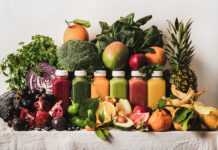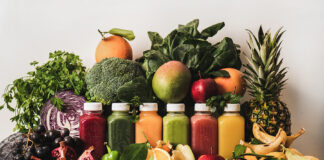
By Holly Gamage, Director of Clean Earth’s Fullcircle™ Business
Today, an estimated one-third of all the food produced in the world goes to waste. That is millions of tons of food that may never leave the farm, is lost or spoiled during processing, production and distribution or is thrown away by manufacturers and distributors, grocery stores, restaurants, schools, consumer home kitchens and more.
According to the World Wildlife Fund (WWF), “It could be enough calories to feed every undernourished person on the planet. But wasted food isn’t just a social or humanitarian concern – it’s an environmental one. When we waste food, we also waste all the energy and water it takes to grow, harvest, transport and package it.” If food goes to the landfill and rots, it produces methane, a greenhouse gas even more potent than carbon dioxide.
Overall, food waste is the cause of 8% of global greenhouse gas emissions. Everything a food and beverage organization or processor can do to reduce, reuse and recycle helps decrease the carbon footprint.
Over the past five years, there has been an increased focus on decreasing food waste, with the United States Department of Agriculture (USDA) and Environmental Protection Agency (EPA) calling for a 50% reduction in food loss and waste by 2030. There is great motivation for the food and beverage industry and its partners to focus on achieving this target, as it requires action from the entire food system prior to reaching the consumer.
Reducing food and beverage waste
To meet this national goal, as well as individual corporate sustainability objectives, it is important to find a sustainability partner who shares the organization’s long-term vision. These partners can assist in assessing the waste cycle, which can include:
- Evaluate packaging and going upstream from there. Often, this means going back to the beginning and looking at the complete process from a different perspective.
- Look at all the different components, from package design to processing, logistics and distribution, byproduct production and more.
- Determine what can be prevented from being generated in the first place.
- Consider how to reduce the company’s carbon footprint and the logistics of where things need to move.
There are also several important questions a sustainability partner can ask. These can include:
- Where is the organization in its sustainability journey?
- Is it on pace with the USDA and EPA goal?
- Has it already met the USDA and EPA goal?
- Is the focus right now primarily on the packaging piece or the non-viable products?
- What are the things we cannot control in the entire food and beverage journey?
Additionally, the pandemic and other emergencies have shown there is a need to have a contingency plan in place. It is important to have alternate avenues prepared to increase recycling or discard spoiled products. Massive amounts of waste that do not have a sustainable outlet (rather than going to a landfill) has a negative cost to a brand’s bottom line and environmental impact.
Finding solutions for reduction
Food and beverage manufacturers must be assured they have the brand protection, proper management technique and sustainability solution for non-viable products, whether it be spoiled, damaged or otherwise defective. This may come with a process to look at product packaging as a component of the overarching journey.
Wastes come in many forms – liquids and solids products, as well as a variety of packaging. This leads to complex management in building a variety of solutions, based on volumes, mix, separation, pre-processing, packaging and material, that fit various recycling solutions. Such solutions may be composting, ethanol and sugar recovery, anaerobic digestion, substitutes for fossil fuels, and/or recycling. Most importantly, the manufacturer can ensure it is not landfilled. For example: There are millions and millions of filled (or unfilled) cans and bottles every day that do not make it to store shelves. Thinking beyond cans and bottles, drink dispensers in fast food restaurants and gas stations often require use of refill cups and bags of concentrate or other substances that may not be able to be utilized for various reasons. While these materials may not be as visible to the consumer, improper management of these materials does ultimately impact the consumer.
Finding the right partner
Finding the right partner to help with the journey of reducing waste and improving sustainability is a critical step. While a food and beverage manufacturer is focused on its own products and distribution to the consumer – whether that is another business or the end consumer – the sustainability partner is focused on providing the expertise for all the components behind it to build the right sustainability program, aiming towards the client’s long-term vision.
Find a partner who will:
- Work alongside the organization to determine the best sustainability solutions for its specific needs, rather than utilizing a one-size-fits-all approach.
- Look at the organization’s long-term goals and projections. The partner’s solution should be tailored to a specific waste journey and be aligned with waste generation, sustainability goals and growth plans.
- Offer enhanced tracking, reporting and data analysis of waste streams to monitor performance and measure against financial and corporate sustainability goals.
- Serve as a long-term partner – because it takes time to develop solutions that will bring a company to zero waste. From one food and beverage manufacturer to the next, there are different needs, priorities and different products and materials being generated.
- Recognize where an organization is on its sustainability journey. Some food and beverage brands are just trying to get out of landfill before they can begin to think about reducing materials, while others are challenged with accurate data and risk or are taking final steps towards achieving zero waste. A sustainability partner should have the experience to assist an organization at any stage.
- Offer core benefit of compliance and risk avoidance by ensuring programs are developed to uphold compliance with all environmental regulations. While protecting the environment and consumers is the priority, also keep brand protection top of mind. There are major risks and negative outcomes that can result when organizations handle materials and products in a manner that is not sustainable. A partner should not only be able to build a sustainability program, but they should also have a team of compliance experts to support it.
Exploring the benefits
There are many advantages from a brand perspective of eliminating waste streams, including the fact that consumers today want more than just quality from the companies they buy from – and often look for products and brands that align with their personal values. Sustainability is a big factor when it comes to influencing business decisions.
Food and beverage manufacturers can and do take advantage of their messaging to consumers regarding the strides being made on their sustainability journey. For example, sharing steps like moving to 100% recycled polyethylene terephthalate, reducing use of virgin plastics and sourcing milk from grass-fed cows, or increasing the percent of waste byproducts being either reduced or recycled can be suitable for external marketing. Consumers and businesses want to know where the manufacturer is on its sustainability journey and how it is producing less waste and increasing product reuse.
Looking towards the future
The food and beverage industry’s challenge should be to serve more customers while wasting less of what is already produced. There are many actions manufacturers and processors can take to improve sustainability – and every small step can help curb harm to the environment.
A partner should have no limitations on the type of waste problem an organization needs to solve. Work together to find ways to make it easier to recycle, repurpose and/or reuse – or in some cases safely destroy – spoiled products or unsalable components of a product. Food and beverage manufacturers need a partner who will take a hands-on, dedicated approach to achieve sustainability goals.
 Holly Gamage is the Senior Director of Clean Earth’s Fullcircle™ business, an Advanced Waste Lifecycle Program. This program strategically analyzes waste and all related byproducts at each source of generation, including upstream, then builds and offers solutions for recycling and beneficial reuse alternatives for the material. Holly is responsible for the overall operations, client services, innovation, continuous improvement, development and implementation of Fullcircle™. Her leadership has led to teams providing creative innovative solutions for recycling, minimizing waste and building sustainable client partnerships and superior customer-centric programs exceeding client KPIs.
Holly Gamage is the Senior Director of Clean Earth’s Fullcircle™ business, an Advanced Waste Lifecycle Program. This program strategically analyzes waste and all related byproducts at each source of generation, including upstream, then builds and offers solutions for recycling and beneficial reuse alternatives for the material. Holly is responsible for the overall operations, client services, innovation, continuous improvement, development and implementation of Fullcircle™. Her leadership has led to teams providing creative innovative solutions for recycling, minimizing waste and building sustainable client partnerships and superior customer-centric programs exceeding client KPIs.










